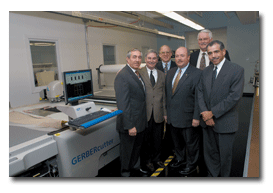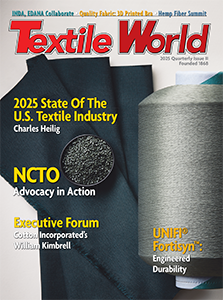T
he Bush administration’s highly touted “ top-to-bottom review” of its trade policies with
China has created considerable interest among textile manufacturers and importers, and they are
closely watching how the rhetoric will be translated into action. In the report, the administration
used some of its strongest language in discussing trade with China, saying the United States’
bilateral trade relationship with China “ lacks equity, durability and balance.” The report,
entitled “US Trade Relations: Entering a New Phase of Greater Enforcement and Accountability,” says
“the time has come to readjust our trade policy with respect to China.”
The report calls for expanding the US Trade Representative’s (USTR’s) ability to monitor
Chinese trade and determine whether China is living up to its obligations under the rules of
international trade. In order to do that, the USTR will create a China Enforcement Task Force
headed by a chief counsel for China trade enforcement. It also will add personnel to its Beijing
office in order to expand its information-gathering, enforcement and negotiating capabilities. The
USTR will deal with protection of intellectual property rights as well as such issues as market
access, subsidies and structural problems like currency manipulation that have been bones of
contention with companies and industries doing business with China. The report also promises to
strengthen the executive-congressional partnership on China trade and provide congressional members
and staff with regular briefings about the administration’s China trade policy.
In a letter forwarding the report to key members of Congress, USTR Rob Portman said: “We are
entering a new phase in our bilateral trade relationship, and we must readjust our trade priorities
and resources accordingly. China as a mature trading partner should be held accountable for its
actions and required to live up to its responsibilities.”
While welcoming the report and its high-sounding rhetoric, textile lobbyists in Washington
are concerned about what it all actually means in terms of concrete results. Lloyd Wood of the
American Manufacturing Trade Action Coalition said the report does not have a “roadmap for actions”
for the US government to correct what he sees as major problems. He said the only time anything
meaningful on Chinese textile trade has come about was a result of actions such as the safeguards
that resulted in an agreement to impose quotas on 34 categories of textiles and apparel. He added
that China understands the stick better than the carrot, and there is “too much carrot and not
enough stick in our trade relations with China.”
At a news conference discussing the report, Portman cited the textile safeguards-related
agreement as an example of a “good, tough, but balanced agreement.” NCTO’s Cass Johnson voiced his
concern over rhetoric versus action by saying the language was harsher than ever before, but no
punitive actions were mentioned. He added he hopes the report sets the tone for “more aggressive
action.”
The nation’s retailers —the largest importers of textiles and apparel — see some positive
aspects of the report and nothing that appears to raise any red flags. One concern, as with textile
manufacturers, is how the report will be used as a basis for taking action. Eric Autor, the
Washington-based National Retail Federation’s international trade expert, sees it as a “fairly
objective report” that addresses the benefits of trade with China, as well as some of the problems.
He says retailers agree China should live up to its international obligations, and stronger
enforcement of US and international trade laws is called for where that is not happening. However,
he added, actions should not be taken unless they are appropriate and address real solutions to
problems.
Senators Delay Legislation On Chinese Currency
Steam appears to be running out of
the congressional effort to slap punitive tariffs on Chinese imports to help offset what many see
as an unfair trade practice resulting from China’s currency manipulation. Sens. Lindsey Graham,
R-S.C., and Charles Schumer, D-N.Y., have introduced legislation that would impose a 27.5-percent
duty on Chinese imports, and they originally set a deadline of March 31 to pursue the legislation
if China did not correct its currency imbalance. Following a trip to Beijing in March, the senators
agreed to postpone action on the legislation until September 29 to give China more time to act on
the currency issue. They said discussions during the visit indicated China may make some moves to
correct the problem.
Last July, the Bank of China announced a 2-percent adjustment in the currency rate, in a
move that was quickly denounced by US manufacturers as “woefully inadequate.” They contend the
currency manipulation amounts to as much as a 40-percent subsidy on China’s imports entering the
United States. Upon his return from Beijing, Graham said currency revaluations made since the
introduction of his legislation are steps in the right direction, and he does not believe they
represent total reform. “My message to the Chinese was the status quo is devastating to American
manufacturers, and they need to embrace reform over time, allowing their currency to float,” he
said. “The small progress we have seen needs to continue. I’m willing to abandon the need for
tariffs if the Chinese embark on real reform, and we are not there yet.”
While the Schumer-Graham bill received 67 votes on a procedural vote last April, it has
generally been viewed simply as a threat to get some action out of the Chinese, as it does not have
a realistic chance of being enacted. The Bush administration is flatly against it, and it very
likely would be illegal under rules of the World Trade Organization (WTO). Meanwhile, the
Washington-based China Currency Coalition — an alliance of industry, agriculture and labor
organizations including textile manufacturers — is pursuing the issue on several fronts. While
continuing to support the Schumer-Graham actions, it sees legislation in the House of
Representatives as a more practical approach to solving the problem. H.R. 1498, introduced by Reps.
Tim Ryan, D-Ohio, and Duncan Hunter, R-Calif., would define currency manipulation as an illegal
trade practice and would allow the United States to levy countervailing duties on products from
offending nations, particularly China. Up to this point, the Department of Commerce had held that
it could not initiate investigations against nonmarket economies — something that has been a source
of great frustration for US textile manufacturers.
Trade Liberalization Negotiations Are In Trouble
Everyone knew it was not going to be easy. These things never are. Big countries line up against
the small ones. Politically powerful farmers want to protect their interests, labor unions are
concerned about job losses and seek to improve working conditions in less developed countries, and
battle lines are drawn between free traders and protectionists. How you get 145 countries big and
small with diverse interests to agree on anything is a tremendous job.
Today, that is the case with the Doha Round of WTO trade liberalization negotiations, and
some people are saying the talks not only are in trouble, they could fail. The powerful chairman of
the House of Representatives Ways and Means Committee recently said “irreconcilable differences”
between the United States and Europe have scuttled the talks. Other trade authorities in Washington
admit the talks are in trouble, but they are not prepared to say they are dead.
For US textile manufacturers and importers of textiles and apparel, the demise of the talks
would be a major problem.
In order to jump-start the negotiations, outgoing USTR Rob Portman has stated the United
States is prepared to take new initiatives and “move aggressively” on tariff reductions. Importers
of textiles and apparel strongly support tariff reductions, as they believe a duty-free, quota-free
world would provide them with greater flexibility in sourcing products at the best prices and in
the time frames needed. While US textile manufacturers have been wary of tariff reductions, at this
point they seem to be willing to take their chances if they can get what they see as a much bigger
prize — a permanent safeguard mechanism that would allow quotas to be imposed on products for which
it can be demonstrated there is market disruption or a threat of market disruption.
The departure of Portman as USTR has further complicated the picture. He has received high
marks both at home and abroad. He had developed sound relationships with his counterparts
throughout, and he had a good working relationship with members of Congress.
His successor and former deputy, Susan C. Schwab, has considerable experience in dealing with
world trade issues, but it remains to be seen how well she can fill Portman’s shoes.
Looking at all of the tough issues that need to be resolved and the uncertain road ahead,
Eric Autor, the Washington-based National Retail Federation’s international trade expert, warned, “
[I]f there is no [Doha] Round, no one gets what they want.”
May/June 2006






